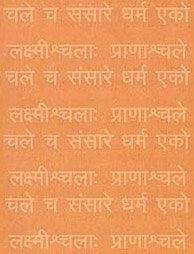Shamkarananda, Śaṃkarānanda, Shankarananda: 4 definitions
Introduction:
Shamkarananda means something in Hinduism, Sanskrit. If you want to know the exact meaning, history, etymology or English translation of this term then check out the descriptions on this page. Add your comment or reference to a book if you want to contribute to this summary article.
The Sanskrit term Śaṃkarānanda can be transliterated into English as Samkarananda or Shamkarananda, using the IAST transliteration scheme (?).
In Hinduism
Vedanta (school of philosophy)
Source: Hindupedia: Later AdvaitinsŚaṃkarānanda, c. 13th/14th century CE, authored several Upaniṣad-dīpikās (among them the Māṇḍūkya and the Kauṣītakī), as well as the Ātmapurāṇa and the Bhagavadgītā-tātparya-bodhinī.

Vedanta (वेदान्त, vedānta) refers to a school of orthodox Hindu philosophy (astika), drawing its subject-matter from the Upanishads. There are a number of sub-schools of Vedanta, however all of them expound on the basic teaching of the ultimate reality (brahman) and liberation (moksha) of the individual soul (atman).
Languages of India and abroad
Sanskrit dictionary
Source: Cologne Digital Sanskrit Dictionaries: Aufrecht Catalogus Catalogorum1) Śaṅkarānanda (शङ्करानन्द) as mentioned in Aufrecht’s Catalogus Catalogorum:—son of Vāñcheśa and Veṅkaṭāmbā, pupil of Ānandātman, guru of Sāyaṇa (Oxf. 222^a): Ātmapurāṇa or Upaniṣadratna, the substance of a number of Upaniṣads, in verse. He wrote dīpikās on the following Upaniṣads: Atharvaśikhā, Atharvaśiras, Atharvaśīrṣa, Amṛtanāda, Amṛtabindu, Āruṇī, Īśāvāsya, Aitareya, Kāṭhaka, Keneṣita, Kaivalya, Kauṣītaka, Garbha, Chāndogya, Jābāla, Taittirīya, Nārāyaṇa, Nṛsiṃhatāpanīya, Paramahaṃsa, Praśna, Brahman, Brahmavallī, Mahopaniṣad, Māṇḍūkya, Muṇḍaka, Śvetāśvatara, Haṃsa. Bhagavadgītātātparyabodhinī. Yatyanuṣṭhānapaddhati. Śivasahasranāmaṭīkā. Sarvapurāṇasāra.
2) Śaṅkarānanda (शङ्करानन्द):—Brahmasūtradīpikā.
3) Śaṅkarānanda (शङ्करानन्द):—pupil of Ānandātman: Vivekasāra, vedānta.
4) Śaṅkarānanda (शङ्करानन्द):—the author of the Dīpikāḥ on Upaniṣads, preceded Nārāyaṇa, who frequently quotes him.
5) Śaṅkarānanda (शङ्करानन्द):—Śrutigītāṭīkā.
Source: Cologne Digital Sanskrit Dictionaries: Monier-Williams Sanskrit-English DictionaryŚaṃkarānanda (शंकरानन्द):—[from śaṃkara > śam] m. Name of a philosopher (son of Vāñcheśa and Veṅkaṭāmbā, pupil of Ānandātman and guru of Sāyaṇa; author of the Ātma-purāṇa or Upaniṣad-ratna, containing the substance of a number of Upaniṣads in verse; and of many Commentaries on Upaniṣads and similar works.)
[Sanskrit to German]
Sanskrit, also spelled संस्कृतम् (saṃskṛtam), is an ancient language of India commonly seen as the grandmother of the Indo-European language family (even English!). Closely allied with Prakrit and Pali, Sanskrit is more exhaustive in both grammar and terms and has the most extensive collection of literature in the world, greatly surpassing its sister-languages Greek and Latin.
See also (Relevant definitions)
Starts with: Shamkaranandanatha, Shamkaranandatirtha.
Full-text (+41): Vanchesha, Shamkaranandatirtha, Shamkaranandanatha, Amritanadopanishaddipika, Pancoli, Upanishadratna, Sarvapuranasara, Anandatman muni, Yatyanushthanapaddhati, Atmapurana, Atharvashikhopanishad, Amritanadopanishad, Amritabindupanishad, Shrutigita, Vivekasara, Atharvashirshopanishad, Atharvashira upanishad, Aruneyopanishad, Brahmopanishad, Garbhopanishad.
Relevant text
Search found 6 books and stories containing Shamkarananda, Śaṃkarānanda, Shankarananda, Samkarananda, Śaṅkarānanda, Sankarananda; (plurals include: Shamkaranandas, Śaṃkarānandas, Shankaranandas, Samkaranandas, Śaṅkarānandas, Sankaranandas). You can also click to the full overview containing English textual excerpts. Below are direct links for the most relevant articles:
Preceptors of Advaita (by T. M. P. Mahadevan)
A History of Indian Philosophy Volume 2 (by Surendranath Dasgupta)
Part 25 - Vidyāraṇya (a.d. 1350) < [Chapter XI - The Śaṅkara School of Vedānta (continued)]
Part 8 - Maṇḍana, Sureśvara and Viśvarūpa < [Chapter XI - The Śaṅkara School of Vedānta (continued)]
Part 7 - Śaṅkara and his School < [Chapter XI - The Śaṅkara School of Vedānta (continued)]
Complete works of Swami Abhedananda (by Swami Prajnanananda)
Preface < [Discourse 6 - An Introduction to the Philosophy of Panchadasi]
A comparative study between Buddhism and Nyaya (by Roberta Pamio)
7.2. Mental Perception (Manasa Pratyakṣa) < [Chapter 3 - The Buddhist Theory of Perception]
Lakulisha-Pashupata (Philosophy and Practice) (by Geetika Kaw Kher)
Early Textual References < [Chapter 1 - The Historical Context]
Bhagavatpadabhyudaya by Lakshmana Suri (study) (by Lathika M. P.)
Śaṅkaradigvijaya (list of available works) < [Chapter 4 - Similarities and Dissimilarities]